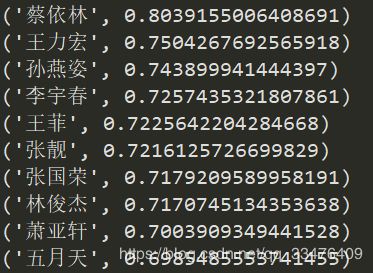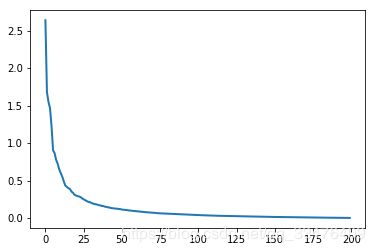python+word2vec+随机森林 微博文本情感极性分析(一)
数据源:36万条微博文本,已标注情感。源数据中label0:开心,label1-3:低落或忧伤。本文只考虑情感正负极性,所以1-3都划为负样本。
项目思路:分词后利用gensim.models.word2vec训练词向量,词向量表示训练集文本,sklearn训练随机森林模型,auc=0.86。
加载相关python包:
import jieba
import re
import pandas as pd
from gensim.models import word2vec
import numpy as np
from sklearn.decomposition import PCA
from sklearn.ensemble import RandomForestClassifier as RF
import matplotlib.pyplot as plt
from sklearn.metrics import roc_curve,auc
from sklearn.cross_validation import train_test_split
word2vec训练词向量
利用这36万微博数据训练词向量,word2vec需要语料分词。
data = pd.read_csv('F:/weibo_4_moods.csv',delimiter=',',header=0,encoding='utf-8')
file_train = 'F:/word_train.txt'
def get_word_train(filename):
with open(filename,'w',encoding='utf-8') as f:
for line in data['review']:
word_l = ' '.join(jieba.cut(line,cut_all=False))
word_l.replace(u',',u'').replace(u'。',u'').replace(u';',u'').replace(u'!',u'').replace(u'~',u'').replace(u'【',u'').replace(u'】',u'').replace(u'.',u'').replace(u'-',u'')
f.write(word_l)
f.write(u'\n')
f.close()
get_word_train(file_train)
分词后文本word_train.txt:

word2vec训练得到词向量保存在corpus.model。
sent = word2vec.Text8Corpus(file_train)
model = word2vec.Word2Vec(sent,size=200)
model.save('corpus.model')
model = word2vec.Word2Vec.load('corpus.model')
indexes = model.most_similar(u'周杰伦',topn=10)
for index in indexes:
print(index)
训练集句子用word2vec词向量表示
加载停用词:
file1 = 'F:/xiaoyan/study/data/text class/stopword.txt'
def stopw(file):
stopword = []
with open(file1,'r',encoding='utf-8') as text:
s = re.split(u'\n',text.read())
for word in s:
stopword.append(word)
return stopword
stopword = stopw(file1)
句子的词向量是每个词的词向量的均值:
def getvec(sent):
senvec = []
word_l = jieba.cut(sent)
for word in word_l:
if word in stopword:
continue
else:
try:
senvec.append(model[word])
except:
pass
return np.array(senvec,dtype='float')
def build_vec(data):
Input = []
for line in data['review']:
vec = getvec(line)
if len(vec)!=0:
res = sum(vec)/len(vec)
Input.append(res)
return Input
得到正负样本及数据标签y,1为正:
pos = build_vec(data[data.label==0])
neg = build_vec(data[data.label>0])
y = np.concatenate((np.ones(len(pos)),np.zeros(len(neg))))
X = pos[:]
for n in neg:
X.append(n)
PCA
根据训练集维度与方差的关系图,对X降维到100维。
pca = PCA().fit(X)
plt.plot(pca.explained_variance_,linewidth=2)
X_reduced = PCA(n_components=100).fit_transform(X)
随机森林弱分类器训练200次
X_train,X_test,y_train,y_test = train_test_split(X_reduced,y,test_size=0.3)
clf = RF(n_estimators=200)
clf.fit(X_train,y_train)
print("准确率:%s" % clf.score(X_test,y_test))
ROC曲线
from sklearn.metrics import roc_curve,auc
y_pred = clf.predict_proba(X_test)[:,1]
fpr,tpr,_ = roc_curve(y_test,y_pred)
roc_auc = auc(fpr,tpr)
plt.plot(fpr,tpr,label ='area=%.2f' %roc_auc)
plt.legend(loc='lower right')


